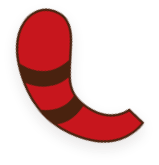| 2-(1-(Thiophen-2-yl)ethylidene)hydrazinecarbothioamide is an antimicrobial agent.1It is active against the Gram-negative bacteriaE. coli,P. aeruginosa, andS. marcescens(MICs = 64, 100, and 70 μg/ml, respectively), the Gram-positive bacteriaS. aureus,M. luteus, andB. cereus(MICs = 130, 100, and 50 μg/ml, respectively), and the fungiC. albicans,G. candidum,T. rubrum,F. oxysporum,A. flavus, andS. brevicaulis(MICs = 69-120 μg/ml). 2-(1-(Thiophen-2-yl)ethylidene)hydrazinecarbothioamide is also a precursor in the synthesis of other antimicrobial agents, as well as compounds with anticancer activity.1,2
1.Youssef, M.S.K., and Abeed, A.A.O.Synthesis and antimicrobial activity of some novel 2-thienyl substituted heterocyclesHeterocycl. Commun.20(1)25-31(2014) 2.Gomha, S.M., Edrees, M.M., and Altalbawy, F.M.A.Synthesis and characterization of some new bis-pyrazolyl-thiazoles incorporating the thiophene moiety as potent anti-tumor agentsInt. J. Mol. Sci.17(9)1499(2016) |
| 2-deoxy-D-Glucose-13C6is intended for use as an internal standard for the quantification of 2-deoxy-D-glucose by GC- or LC-MS. 2-deoxy-D-Glucose is a glucose antimetabolite and an inhibitor of glycolysis.1,2It inhibits hexokinase, the enzyme that converts glucose to glucose-6-phosphate, as well as phosphoglucose isomerase, the enzyme that converts glucose-6-phosphate to fructose-6-phosphate.32-deoxy-D-Glucose (16 mM) induces apoptosis in SK-BR-3 cells, as well as inhibits the growth of 143B osteosarcoma cells cultured under hypoxic conditions when used at a concentration of 2 mg/ml.4,5In vivo, 2-deoxy-D-glucose (500 mg/kg) reduces tumor growth in 143B osteosarcoma and MV522 non-small cell lung cancer mouse xenograft models when used alone or in combination with doxorubicin or paclitaxel .6
1.Kang, H.T., and Hwang, E.S.2-Deoxyglucose: An anticancer and antiviral therapeutic, but not any more a low glucose mimeticLife Sci.78(12)1392-1399(2006) 2.Aft, R.L., Zhang, F.W., and Gius, D.Evaluation of 2-deoxy-D-glucose as a chemotherapeutic agent: Mechanism of cell deathBr. J. Cancer87(7)805-812(2002) 3.Ralser, M., Wamelink, M.M., Struys, E.A., et al.A catabolic block does not sufficiently explain how 2-deoxy-D-glucose inhibits cell growthProc. Natl. Acad. Sci. USA105(46)17807-17811(2008) 4.Liu, H., Savaraj, N., Priebe, W., et al.Hypoxia increases tumor cell sensitivity to glycolytic inhibitors: A strategy for solid tumor therapy (Model C)Biochem. Pharmacol.64(12)1745-1751(2002) 5.Zhang, X.D., Deslandes, E., Villedieu, M., et al.Effect of 2-deoxy-D-glucose on various malignant cell lines in vitroAnticancer Res.26(5A)3561-3566(2006) 6.Maschek, G., Savaraj, N., Priebe, W., et al.2-deoxy-D-glucose increases the efficacy of adriamycin and paclitaxel in human osteosarcoma and non-small cell lung cancers in vivoCancer Res.64(1)31-34(2004) |




 沪公网安备 31010602004043号
沪公网安备 31010602004043号


